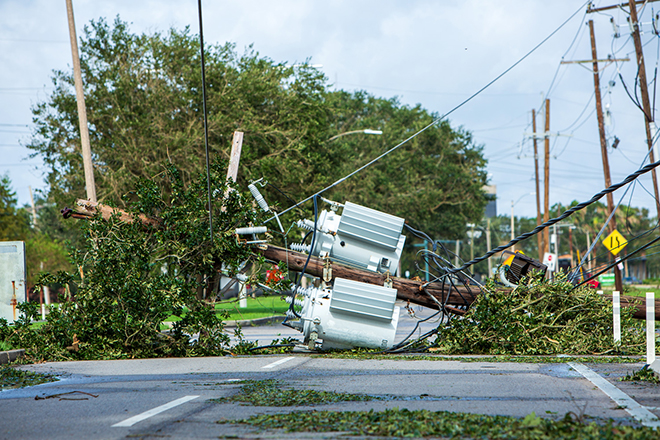S&P Global Offerings
Featured Topics
Featured Products
Events
S&P Global Offerings
Featured Topics
Featured Products
Events
S&P Global Offerings
Featured Topics
Featured Products
Events
Banking & Capital Markets
Economy & Finance
Energy Transition & Sustainability
Technology & Innovation
Podcasts & Newsletters
Banking & Capital Markets
Economy & Finance
Energy Transition & Sustainability
Technology & Innovation
Podcasts & Newsletters
S&P Global Offerings
Featured Topics
Featured Products
Events
31 Aug, 2021
By Darren Sweeney

| Hurricane Ida, which made landfall Aug. 29 in Louisiana as a Category 4 storm, left more than 1 million residents without power, most of them customers served by Entergy Corp. |
With New Orleans still in the dark more than 24 hours after Hurricane Ida roared ashore, an Entergy Corp. executive said the powerful storm barreled along the company's transmission system with "jaw-dropping wind" pummeling its infrastructure.
"The path of the storm was trailing our transmission system," Rod West, group president of utility operations for Entergy, told S&P Global Market Intelligence. "When you think about the configuration of that spider web of the transmission grid ... it's like the storm hugged it."
On Aug. 29, Entergy reported that "all eight transmission lines that deliver power into the New Orleans area" were out of service and West said "100%" of the utility's customers in New Orleans were without power the evening of Aug. 30.
In an early Aug. 30 update, Entergy reported that 216 substations, 207 transmission lines and more than 2,000 miles of transmission lines were out of service, including a transmission line spanning the Mississippi River.
"There are a whole host of reasons, starting with straight-line winds [and] tornadic activity, that created the circumstance with the [transmission] lines serving New Orleans being compromised the way that they were," West said. "That explosive intensification of the storm ... really manifested itself with just some really jaw-dropping wind numbers."
Ida made landfall at about 11:55 a.m. CT on Aug. 29 in southeastern Louisiana as a Category 4 hurricane with winds up to 150 mph, according to the National Hurricane Center. The first landfall of the powerful storm was reported near Port Fourchon, La., which is about 100 miles southwest of New Orleans.
On Aug. 31, Ida was moving slowly across northern Mississippi into Alabama and Tennessee as a tropical depression with heavy rainfall and the potential for flash flooding.
As of 5 p.m. ET on Aug. 31, more than 1 million residents in Louisiana, including 785,308 Entergy customers, were still without power, according to PowerOutage.US, a project that tracks power outages in the country. There were 45,826 outages reported in Mississippi at the time.
"You and I both know that Mother Nature is still the undisputed, undefeated, heavyweight champion of the world," West said. "We respect her. We try to create resiliency around it. That is the nature of our capital program. But this one brought a really devastating punch to the fight."
The executive confirmed that Entergy Louisiana LLC's 1,177-MW Waterford 3 nuclear plant was taken offline and the utility's 968-MW River Bend is operating at reduced capacity, but noted the capacity is available if called upon.
West added that the "generating assets closest to New Orleans," such as the 126-MW natural gas-fired New Orleans Power Station and 594-MW Ninemile 6 combined-cycle natural gas plant, are "waiting for transmission to come online so we can begin the process of restoration."

Entergy New Orleans LLC said Aug. 30 that it had more than 4,500 "boots on the ground" working to evaluate the extent of damage to its system from the storm, which will determine the timeline for power restoration. Entergy warned that some customers in the hardest-hit areas could face outages for weeks.
"This is day one of damage assessment," West said. "Are there going to be customers who are able to energize sooner rather than later? We believe that to be the case. But is there likely going to be some significant work to repair or replace some of the transmission infrastructure? It's a high probability just given some of the straight-line winds and tornadic activity."
Entergy will prioritize police departments, fire stations, hospitals and nursing homes in the restoration process. The company then plans to shift to a more general effort.
"We'll be trying to configure the system in a way that brings as many customers online at one time as we possibly can," West said, noting that the company will then evaluate reliability and resiliency of the grid.
"The truth of the matter is we've been here before," West said, referring to Ida's landfall on the 16th anniversary of Hurricane Katrina in 2005. "While that was a water event, this is a wind event."
"But I view the events perhaps more by the impact that it has on the people," he added. "I know that this is an impactful storm."
West stopped short of directly comparing Ida to Hurricane Katrina, a Category 5 storm that killed more than 1,800 people along the Gulf Coast and caused billions of dollars in damage in New Orleans.
"The similarity is the approximate result of the storm was that we had 100% of the customers here out," West said. "The dynamics around the type of damage, the length of restoration, the cost of restoration, I suspect are going to be different, but I won't know until we go through the damage assessment process."
